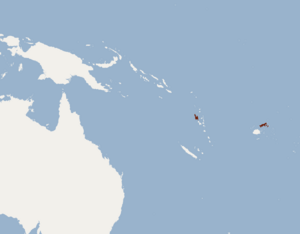Fijian mastiff bat facts for kids
Quick facts for kids Fijian free-tailed bat |
|
|---|---|
| Conservation status | |
| Scientific classification | |
| Genus: |
Mops
|
| Species: |
bregullae
|
 |
|
The Fijian free-tailed bat is a special type of bat found in Fiji and Vanuatu. Its scientific name is Mops bregullae. This bat is also sometimes called the Fijian mastiff bat.
In 2013, a group called Bat Conservation International listed this bat as one of the top 35 species they wanted to help protect worldwide. Today, the Fijian free-tailed bat is listed as endangered. This means it is at high risk of disappearing forever.
Scientists are worried about this bat because its natural home is being broken up. Also, the caves where it lives are often disturbed by people. The Fijian free-tailed bat is only found in Fiji and Vanuatu. It was once seen on the islands of Taveuni and Vanua Levu. Now, scientists believe only small groups of these bats might still live there.
Only two types of bats that eat insects live in Fiji. These are the Pacific sheath-tailed bat and the Fijian free-tailed bat. Both kinds of bats hunt for flying insects at night. They fly high above the treetops to find their food.
Contents
How Many Fijian Free-Tailed Bats Are Left?
Scientists estimate there are about 7,000 Fijian free-tailed bats left in the world. Their numbers are going down for a few reasons. People disturbing their caves is one problem. Also, too many bats might be caught or hunted. Cutting down forests also destroys their homes. These issues are causing the bat population to shrink across the areas where they live.
Where Do Fijian Free-Tailed Bats Live?
Scientists are still learning about where these bats live and how they use their environment. In the past, Fijian free-tailed bats were seen living in caves on Vanuatu. People have also seen them hunting for food in different places in Fiji. These include coconut farms, other farmlands, forests, and areas near the coast.
Protecting the Fijian Free-Tailed Bat
The IUCN (International Union for Conservation of Nature) says the Fijian free-tailed bat is endangered. This means it is very close to becoming extinct.
In 2018, the first bat sanctuary in Fiji was created. The National Trust of Fiji bought Nakanacagi Cave to protect it. This cave is an important home for the Fijian free-tailed bat. Sadly, these bats are no longer found in Tonga. This is because their homes were disturbed, and too many bats were caught there.
Images for kids



